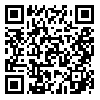BibTeX | RIS | EndNote | Medlars | ProCite | Reference Manager | RefWorks
Send citation to:
URL: http://jdisabilstud.org/article-1-2328-en.html
2- Psychology Department, Karaj Branch, Islamic Azad University
Background & Objectives: Test anxiety is a disturbing response that occurs in threatening situations related to student performance appraisal, so test anxiety is associated with poor academic performance. The focus of test anxiety is doubt about self–performance and self–efficacy and concern about the consequences, significantly reducing the student's ability to cope with the problem–solving situation and his/her inability. The greater the anxiety in this case, the lower the academic self–efficacy. The experiences that students face during their school years, such as test anxiety and their performance at the time of assessment, not only affect their sense of self–efficacy but also shape their sense of self–efficacy and competence. In turn, it may affect academic achievement. Learning self–regulation stems from the interaction of learning strategies and motivational beliefs (self–efficacy). Cognitive strategies of cognitive learning strategies are strategies that improve the learner's ability to process information more deeply, transfer and use information in new situations, and lead to enhanced learning and learning continuity. This study aimed to determine the effectiveness of cognitive strategies education on test anxiety and perceived self–efficacy of female high school students.
Methods: The research method was quasi–experimental with a pretest–posttest and 3 months follow–up design with a control group. The statistical population included female high school students in Tehran in 2019, and 28 people (for each group) were selected using the available sampling method from eligible individuals based on the cut–off score of 50 on the Test Anxiety Questionnaire (Abolghasemi et al., 1996). After the homogenization of the study field, they were randomly divided into experimental and control groups. The inclusion criteria were as follows: not receiving interventions such as self–efficacy by the school counselor, providing informed consent, and being willing to cooperate with teenagers and their families in this research. The exclusion criteria were as follows: the non–cooperation of the family and students during the treatment and the number of absent sessions of more than two sessions. The study tools included the Self–Efficacy Scale (Sherer et al., 1982) and Test Anxiety Questionnaire (Abolghasemi et al. 1996). Five sessions of cognitive strategies education for the experimental group were run and no intervention was presented for the control group. To describe the data, the statistical methods of frequency and percentage, mean and standard deviation were used in the present study. Also, the repeated measures of analysis of variance and Bonferroni's post hoc test were used to analyze the data in SPSS version 22 software. The significance level of the tests was considered 0.05.
Results: In the present study, cognitive strategies education to the experimental group reduced test anxiety (p=0.002) compared to the control group. Also, the mean test anxiety during the study time showed a significant difference between the experimental and control groups (p<0.001). Cognitive strategies education for the experimental group increased the perceived self–efficacy (p<0.001) compared to the control group. Also, the mean perceived self–efficacy during the study time showed a significant difference between the experimental and control groups (p<0.001). The comparison of the averages of the pretest with the posttest (p<0.001) and pretest with follow–up (p<0.001) was significant for the test anxiety variable. Also, the positive effect of cognitive strategies training in the experimental group and the persistence of this effect in the follow–up phase was significant (p<0.001). The averages of the pretest with posttest (p<0.001) and the pretest with follow–up (p<0.001) were significant for the self–efficacy variable. Also, the positive effect of cognitive strategies training in the experimental group continued in the follow–up phase (p=1.000).
Conclusion: Teaching appropriate cognitive strategies tries to increase students' learning and understanding and concentration. Therefore, it improves the performance of students; thus, students' exam anxiety decreases and increases self–efficacy.
| Rights and permissions | |
 |
This work is licensed under a Creative Commons Attribution-NonCommercial 4.0 International License. |



